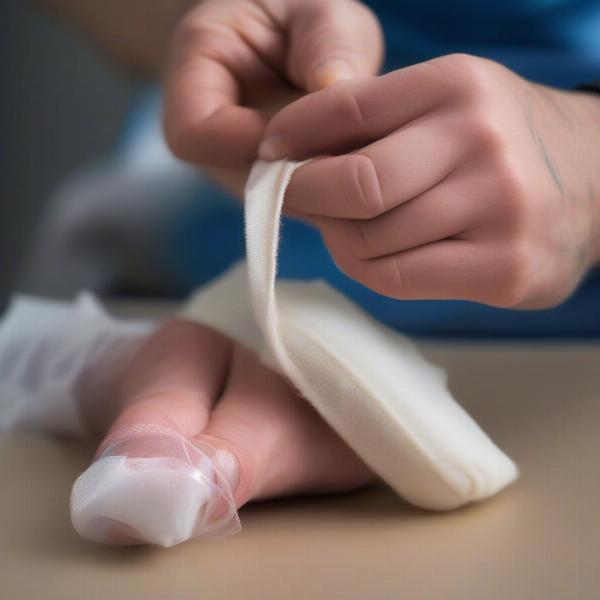A dog’s paw pads are their first line of defense against the harsh elements and everyday wear and tear. So, discovering a ripped paw pad, even if it’s not bleeding, can be alarming. “Dog paw pad ripped off not bleeding” is a common search term for worried pet owners, and understandably so. While a non-bleeding ripped pad might seem less serious, it still requires immediate attention and proper care to prevent infection and further injury. This article will guide you through the necessary steps to take if your dog experiences this type of injury.
Understanding the Severity of a Ripped Paw Pad
While the absence of bleeding is a good sign, a ripped paw pad, even a superficial one, exposes sensitive tissue to the environment. This makes it vulnerable to infection, especially if your dog walks on dirty surfaces. The severity depends on the depth and size of the tear. A small, surface-level rip might heal with minimal intervention, while a deeper tear could require veterinary attention.
What to Do if Your Dog’s Paw Pad is Ripped but Not Bleeding
First, restrain your dog gently and examine the paw. Clean the area with lukewarm water and a mild antiseptic solution. Avoid using hydrogen peroxide or alcohol, as these can damage the tissue and delay healing. Pat the area dry with a clean towel.
Next, apply a pet-safe antibiotic ointment to the ripped pad. This will help prevent infection. You can then cover the paw with a clean bandage or a dog bootie to protect it from further injury and keep it clean.
 Bandaging a Dog's Ripped Paw Pad
Bandaging a Dog's Ripped Paw Pad
When to Seek Veterinary Care
Even if the paw pad isn’t bleeding, it’s essential to monitor it closely for any signs of infection, such as redness, swelling, pus, or increased pain. If you notice any of these signs, or if the tear is deep or involves a large area of the pad, take your dog to the veterinarian immediately. They can assess the injury, clean it thoroughly, and potentially stitch the wound if necessary. They may also prescribe antibiotics to prevent or treat infection.
What can I expect at the vet?
Your veterinarian will thoroughly examine the paw and may recommend an X-ray to rule out any foreign objects or bone fractures. Based on the severity, they might prescribe pain medication, antibiotics, or recommend further treatment.
How can I prevent paw pad injuries?
Regularly check your dog’s paws for cuts, cracks, or foreign objects. Keep their nails trimmed and avoid walking them on hot pavement or rough terrain. Using paw balm can also help protect their pads.
Long-Term Care and Prevention
Once your dog’s ripped paw pad has healed, continue to monitor it for any recurring issues. Keep their paws clean and moisturized with a pet-safe balm. Avoid walking your dog on hot pavement or rough surfaces, especially during the healing process. Consider using dog booties for added protection.
Conclusion
A ripped paw pad, even without bleeding, requires prompt attention. By following the steps outlined in this article, you can help your dog recover quickly and prevent further complications. Remember to consult a veterinarian if you’re unsure about the severity of the injury or notice any signs of infection. “Dog paw pad ripped off not bleeding” shouldn’t be a cause for panic, but it does require careful observation and care.
FAQs
- My dog licked his ripped paw pad. Should I be worried? While dog saliva has some antibacterial properties, excessive licking can irritate the wound and delay healing. Use an Elizabethan collar to prevent your dog from licking the injured paw.
- Can I use human antibiotic ointment on my dog’s paw? It’s best to use a pet-safe antibiotic ointment. Some human ointments contain ingredients that are toxic to dogs.
- How long does it take for a ripped paw pad to heal? Healing time varies depending on the severity of the tear. Minor rips can heal within a week or two, while deeper tears can take several weeks or even months.
- What are the signs of a paw pad infection? Signs of infection include redness, swelling, pus, increased pain, and lameness.
- How can I protect my dog’s paws in the future? Trim your dog’s nails regularly, avoid walking them on hot pavement or rough terrain, and consider using dog booties for added protection.
- My dog is still limping after a few days. What should I do? If your dog continues to limp or shows any signs of discomfort, consult your veterinarian.
- Can a ripped paw pad lead to more serious problems? If left untreated, a ripped paw pad can become infected, leading to more severe complications.
ILM Dog is a dedicated resource for dog owners worldwide, providing expert advice on all aspects of dog care and well-being. From breed selection and puppy care to senior dog health and training, we offer comprehensive, practical information to help you navigate the joys and challenges of dog ownership. Whether you’re a seasoned dog parent or just starting your journey, ILM Dog has the resources you need to provide the best possible care for your canine companion. For expert advice and personalized support, contact us at [email protected] or +44 20-3965-8624. We are committed to providing the latest insights into dog breeds, health, training, nutrition, grooming, and accessories to help you make informed decisions for your furry friend. Reach out to us for any questions or concerns regarding your dog’s health or well-being.